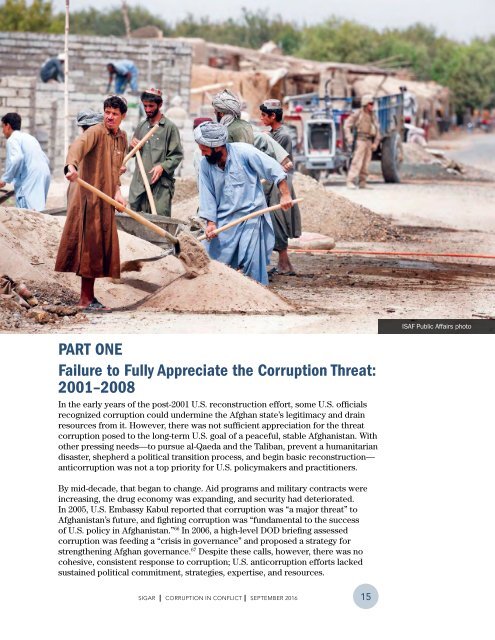CORRUPTION IN CONFLICT
5IlaWjQej
5IlaWjQej
Create successful ePaper yourself
Turn your PDF publications into a flip-book with our unique Google optimized e-Paper software.
ISAF Public Affairs photo<br />
PART ONE<br />
Failure to Fully Appreciate the Corruption Threat:<br />
2001–2008<br />
In the early years of the post-2001 U.S. reconstruction effort, some U.S. officials<br />
recognized corruption could undermine the Afghan state’s legitimacy and drain<br />
resources from it. However, there was not sufficient appreciation for the threat<br />
corruption posed to the long-term U.S. goal of a peaceful, stable Afghanistan. With<br />
other pressing needs—to pursue al-Qaeda and the Taliban, prevent a humanitarian<br />
disaster, shepherd a political transition process, and begin basic reconstruction—<br />
anticorruption was not a top priority for U.S. policymakers and practitioners.<br />
By mid-decade, that began to change. Aid programs and military contracts were<br />
increasing, the drug economy was expanding, and security had deteriorated.<br />
In 2005, U.S. Embassy Kabul reported that corruption was “a major threat” to<br />
Afghanistan’s future, and fighting corruption was “fundamental to the success<br />
of U.S. policy in Afghanistan.” 66 In 2006, a high-level DOD briefing assessed<br />
corruption was feeding a “crisis in governance” and proposed a strategy for<br />
strengthening Afghan governance. 67 Despite these calls, however, there was no<br />
cohesive, consistent response to corruption; U.S. anticorruption efforts lacked<br />
sustained political commitment, strategies, expertise, and resources.<br />
SIGAR I <strong>CORRUPTION</strong> <strong>IN</strong> <strong>CONFLICT</strong> I SEPTEMBER 2016<br />
15


